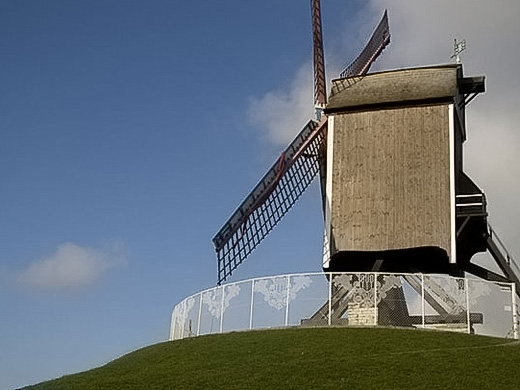Finally installed this morning above EC Row in Windsor, Ontario—YOU ARE AMAZING!
Redesigning Fences
Thinking about the many ways to work with fences, given that we seem to continually insist of putting them up, I found a couple examples lately of artists and designers working to interweave new patterns into chain link fence.

“Lace Fence” by Joep & Jeroen Verhoeven van Demakersvan

“L’Univers”, 2007 by Nicolas Milhé.

A Windsor strategy not fully exploited. Inserting vertical (or horizontal for that matter) strips of plastic of material into a fence could allow other patterns to emerge.
[via DesignBoom & vvork]
New Text In-Transit Submission Form!
Courtesy of the always brilliant Steven …
There’s now a new submission form that allows you to get a quick preview of what your Text In-Transit panel could look like, along with a fun little colour swatch. If you’ve already submitted, it’s worth submitting more just to try this out, and if you haven’t submitted yet—get on it!!!
Check out the NEW Text In-Transit Call for Submissions page!
Or if you’re more comfortable with an old fashioned email, that’s still fine too.
Physics Club + Making Paper

It’s been a busy last week, getting back from Victoria, and launching the Text In-Transit Call For Submissions, but we still had time to meet for our weekly Office Hours and continue working with the Massey Physics Club. Our adventures in paper making for an upcoming planters project we have in mind, and in learning more high school physics and math are after the jump.
Eclipse – Park Pollution Visualization

It seems I keep running into projects that attempt to visualize pollution levels. I’m not sure what intrigues me about this particular project, but I do connect with it on some level. I might just be drawn to projects which use real-time or near-real-time data. Here is a summary this project’s purpose.
“Eclipse is an interactive artwork that alters and corrupts appropriated photographs of United States national and state parks based on real-time Air Quality Index readings from the web (AQI or particle pollution data is available from airnow.gov). Eclipse was commissioned by Turbulence.org and was created by Cary Peppermint and Christine Nadir, who produce ecoarttech.net.”
Text In-Transit: Call For Submissions
Text In-Transit is a Broken City Lab project where we’re partnering with Transit Windsor to install a number of text-based creative works amongst the ads in the headspace on buses. We’re looking for submissions of short statements, poems, and stories from anyone in the city that will help to change the conversation about Windsor!!!
*** Please send your submission(s) to info@brokencitylab.org by March 20, 2009.
We’ll be curating the submissions, so feel free to send more than one. As well, this project is made possible by Transit Windsor, OPIRG, MYAC and The Arts Society at the University of Windsor.
Jenny Holzer’s Projection for Chicago
After meeting with Massey’s Junior Physics Club again today and then discussing that project further at tonight’s Office Hours, trying to figure out exactly what we need to do to make a really large-scale projection happen, I saw this video on Jenny Holzer’s latest Projection for Chicago, as part of her ongoing Xenon Projections series.
Check out the size of her projector near the beginning—insanely huge, but also insanely bright.
[via Art21]
Office Hours

Broken City Lab office hours on Tuesday, March 10, at 7pm, LeBel, room 125. Fresh off a week in the gallery, a conference in Victoria, and realizing a campus just needs some wildlife to make it better, this week’s office hours should be awesome. Sorry the post is late!
Smorgasborder 02: Rewriting Windsor

Last night’s Noiseborder event was a success. A number of people came down to Studio A in Lambton tower and helped us collaboratively rewrite Windsor’s history using maps, time lines, and story boards. All content was digitally remixed and projected on the screen with old photos and videos of Windsor.
Light Transmitting Concrete

Now wouldn’t this be a good idea for some of Lebel’s windowless rooms? This light transmitting concrete was developed in 2004 and is called LitraCon. I’m not having a very easy time thinking of many applications for this recent invention, but I’m sure it could save on lighting costs for rooms in which activities would be carried out during the day.
“Litracon is a combination of optical fibers and fine concrete. The glass fibers lead light by points between the two sides of the blocks. Because of their parallel position, the light-information on the brighter side of such a wall appears unchanged on the darker side. The most interesting form of this phenomenon is probably the sharp display of shadows on the opposing side of the wall. Moreover, the colour of the light also remains the same.”











